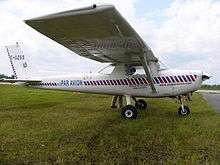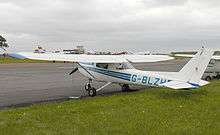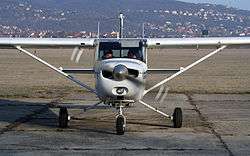Cessna 152
| Cessna 152 | |
|---|---|
 | |
| Cessna 152 | |
| Role | Multipurpose civil aircraft |
| Manufacturer | Cessna |
| Introduction | 1977 |
| Produced | 1977–1985 |
| Number built | 7,584 |
| Developed from | Cessna 150 |
The Cessna 152 is an American two-seat, fixed tricycle gear, general aviation airplane, used primarily for flight training and personal use. It was based on the earlier Cessna 150, including a number of minor design changes and a slightly more powerful engine running on 100LL aviation gasoline.
Development


First delivered in 1977 as the 1978 model year, the 152 was a modernization of the proven Cessna 150 design. The 152 was intended to compete with the new Beechcraft Skipper and Piper Tomahawk, both of which were introduced the same year.[1] Additional design goals were to improve useful load through a gross weight increase to 1670 lbs (757 kg), decrease internal and external noise levels and run better on the then newly introduced 100LL fuel.[2]
As with the 150, the great majority of 152s were built at the Cessna factory in Wichita, Kansas. A number of aircraft were also built by Reims Aviation of France and given the designation F152/FA152.[1]
Production of the 152 was ended in 1985 when Cessna ended production of all of their light aircraft; by that time, a total of 7,584 examples of the 152, including A152 and FA152 Aerobat aerobatic variants, had been built worldwide.
In 2007 Cessna announced that it would build a light sport successor, designated the Model 162 Skycatcher,[3] although production ended in 2013.
Design
Powerplant
All Cessna 152s were manufactured with a Lycoming O-235 engine. The Lycoming provided not only an increase in engine power over the Cessna 150, but also was more compatible with the newer 100LL low lead fuel.[1]
Cessna 152s produced between 1977 and 1982 were equipped with Lycoming O-235-L2C engines producing 110 hp (82 kW) at 2550 rpm. This engine still suffered some lead-fouling problems in service and was succeeded in 1983 by the 108 hp (81 kW) O-235-N2C which featured a different piston design and a redesigned combustion chamber to reduce this problem. The N2C engine was used until 152 production ended in 1985.[1]
Airframe
The airframe is mainly of metal construction. being primarily of 2024-T3 aluminum alloy with riveted skin. Components such as wingtips and fairings are made from glass-reinforced plastic. The fuselage is a semi-monocoque with vertical bulkheads and frames joined by longerons running the length of the fuselage. The wings are of a strut-braced design and have a 1 degree dihedral angle. The tapered (outboard) portion of each wing has one degree of washout (the chord of the tip section has one degree lower angle of attack than the chord at the end of the constant-width section). This allows greater aileron effectiveness during a stall.[4]
Flying controls

Dual controls are available as optional equipment on the Cessna 152[4] and almost all 152s have this option installed.
The Cessna 152 is equipped with differential ailerons that move through 20 degrees upwards and 15 degrees downwards. It has single-slotted flaps which are electrically operated and deploy to a maximum of 30 degrees. The rudder can move 23 degrees to either side and is fitted with a ground-adjustable trim tab. The elevators move up through 25 degrees and down through 18 degrees. An adjustable trim tab is installed on the right elevator and is controlled by a small wheel in the center of the control console. The trim tab moves 10 degrees up and 20 degrees down relative to the elevator chordline.[4]
Landing gear
The Cessna 152 is equipped with fixed tricycle landing gear. The main gear has tubular steel legs surrounded by a full-length fairing with a step for access to the cabin. The main gear has a 7 ft 7 in (2.3 m) wheelbase.[1]
The nosewheel is connected to the engine mount and has an oleo strut to dampen and absorb normal operating loads. The nosewheel is steerable through eight degrees either side of neutral and can castor under differential braking up to 30 degrees. It is connected to the rudder pedals through a spring linkage.[4]
The braking system consists of single disc brake assemblies fitted to the main gear and operated by a hydraulic system. Brakes are operated by pushing on the top portion of the rudder pedals. It is possible to use differential braking when taxiing and this allows very tight turns to be made.[4]
The 152 is also fitted with a parking brake system. It is applied by depressing both toe brakes and then pulling the "Park Brake" lever to the pilot’s left. The toe brakes are then released but pressure is maintained in the system thereby leaving both brakes engaged.[4]
The standard tires used are 600 X 6 on the main gear and 500 X 5 on the nosewheel.[1]
Modifications
There are hundreds of modifications available for the Cessna 152. The most frequently installed include:
Tailwheel landing gear
Taildragger conversions such as the 'Texas Taildragger' conversion are available and have been fitted to some 152s. It involves strengthening the fuselage for the main gear being moved further forward, removing the nosewheel and strengthening the tail area for the tailwheel. This greatly improves short field performance and is claimed to give up to a 10 kn (19 km/h) cruise speed increase.[5][6]
STOL kits
The wings can be modified using a number of STOL modification kits, some improving high speed/cruise performance but most concentrating on STOL performance. Horton's STOL kit is one of the better-known of the latter. It involves fitting a more cambered leading edge cuff to increase the maximum coefficient of lift, fitting fences at the aileron/flap intersection and fitting drooped wingtips. Stalls with these modifications are almost off the airspeed indicator, since instrument error is high at high angles of attack.[5][6] It has been said that landings can be achieved in two fuselage lengths with the kit installed in addition to a taildragger modification, by balancing power against drag.[6] Takeoff performance is also improved by varying degrees depending on the surface.
Engine
The engine's power can be increased by various modifications, such as the Sparrow Hawk power package, increasing it to 125 hp (93 kW).[5][6] The disadvantage of the Sparrow Hawk conversion is that it uses pistons from the O-235-F series engine and therefore the engine recommended time between overhaul is reduced from 2,400 hours to 2,000 hours.[7]
Other modifications
Other popular modifications include:
- Flap gap seals to reduce drag and increase rate of climb.[5]
- Different wingtips, some of which claim various cruise speed increases and stall speed reductions.[5]
- Auto fuel STCs, which permit the use of automobile fuel instead of the more expensive aviation fuel.
- Auxiliary fuel tanks for greater range.[5]
- Door catches to replace the factory ones that often fail in service.[5]
- Belly fuel drain valves to drain fuel from the lowest point in the fuel system.[5]
Variants



- 152
- Two-seat light touring aircraft, fitted with a fixed tricycle landing gear, powered by a 110-hp (82-kW) Lycoming O-235-L2C piston engine, 6628 built.[8] Available with a number of avionic options, aside from the standard Model 152 there was a 152 II with an enhanced package of standard avionics and trim features. The 152 II with Nav Pac included more standard avionics for IFR use. The 152T was a standard option package for use by flying schools, the "T" indicating "trainer" and not a sub-model.[1] Type approved in 1977 and produced as 1978 to 1985 model years.[9]
- A152 Aerobat
- Two-seat aerobatic-capable aircraft, 315 built.[8] Certified for +6/-3 Gs and had standard four-point harnesses, skylights and jettisonable doors, along with a checkerboard paint scheme and removable seat cushions to allow parachutes to be worn by the crew.[1][2] Type approved in 1977 and produced as 1978 to 1985 model years.[9] The following aerobatic maneuvers are approved: chandelles, steep turns, barrel rolls, snap rolls, loops, vertical reversements, lazy eights, spins, aileron rolls, Immelmann turns, Cuban Eights and stalls (except whip stalls).[9]
- F152
- Reims-built Model 152, 552 built.[8]
- FA152 Aerobat
- Reims-built Model A152, 89 built.[8]
Operators
Civilian operators
The 152 is popular with flight training organizations and is also widely operated by private individuals.
Military operators

- Argentine National Gendarmerie operated three from 2004.[10]
- Bangladesh Army four A152 Aerobat procured in 1982[11]
- Bolivian Air Force - 12 in service as of 1987.[12]
- Botswana Defence Force Air Wing two A152[13]
- Gabonese Air Force one F152[14]
- Lesotho Defence Force one A152[15]
- Mexican Navy operated seven from 1979[16]
Incidents and accidents
- On 9 May 1989, a man who had murdered his ex-wife earlier that evening stole a Cessna 152T at gunpoint from an employee at Beverly Municipal Airport. During the flight, which lasted over three hours, Alfred James Hunter III fired an assault rifle at the ground below, buzzed the South Postal Annex in Boston several times, and briefly touched down at Logan International Airport before taking off again. He was arrested when he finally landed with just five minutes worth of fuel remaining.[17]
- On 24 May 2001, a Cessna 152 violated Israeli airspace and was shot down by an IDAF AH-64 Apache. Estephan Nicolian, a Lebanese student pilot, was shot down after ignoring repeated warnings by Israeli ATC to turn back. This is the only known operational air-to-air kill using an AGM-114 Hellfire missile.[18][19]
Specifications (Cessna 152)
Data from Cessna 152 Pilot's Operating Handbook[4]
General characteristics
- Crew: one pilot
- Capacity: one passenger
- Length: 24 ft 1 in (7.3 m)
- Wingspan: 33 ft 4 in (10.2 m)
- Height: 8 ft 6 in (2.6 m)
- Wing area: 160 ft² (14.9 m²)
- Empty weight: 1,081 lb (490 kg)
- Max. takeoff weight: 1,670 lb (757 kg)
- Powerplant: 1 × Lycoming O-235-L2C flat-4 engine, 110 hp (82 kW) driving a 69-inch (175 cm), two-blade, fixed-pitch McCauley propeller or a 72-inch, two-blade, fixed-pitch Sensenich propeller
Performance
- Maximum speed: 126 mph (110 knots, 204 km/h)
- Cruise speed: 123 mph (107 knots, 198 km/h)
- Stall speed: 49 mph (43 knots, 79 km/h) unpowered, flaps down
- Takeoff roll: 725 ft (221 m)
- Range: 477 mi (414 nm, 768 km)
- Extended range 795 mi (690 nm, 1,280 km) with long-range tanks
- Service ceiling: 14,700 ft (4,480 m)
- Rate of climb: 715 ft/min (3.6 m/s)
- Max. wing loading: 10.44 lb/ft² (51 kg/m²)
- Minimum power/mass: .066 hp/lb (108 W/kg)
See also
- Related development
- Aircraft of comparable role, configuration and era
- Alpha 2000 (Robin R2000)
- Beechcraft Skipper
- Diamond DA20
- Grumman American AA-1
- Liberty XL2
- Piper Tomahawk
- Symphony SA-160
- Related lists
References
- 1 2 3 4 5 6 7 8 Clarke, William ‘Bill’ (1987), Cessna 150 and 152 (1st ed.), TAB Books, pp. 26–95, ISBN 0-8306-9022-0.
- 1 2 "1978 Aircraft Directory", Plane and Pilot, Santa Monica, CA: Werner & Werner, p. 23, 1977, ISBN 0-918312-00-0.
- ↑ "Cessna Announces Light Sport Aircraft Details" (press release). Cessna Aircraft. 2007-07-22. Archived from the original on 2007-08-25. Retrieved 2007-09-28.
- 1 2 3 4 5 6 7 Cessna Aircraft Company: 1978 Cessna 152 Pilot's Operating Handbook Change 1, pp. 7-3 to 7-33. Cessna Aircraft Company, Wichita, Kansas, 1977.
- 1 2 3 4 5 6 7 8 Clarke, Bill: Cessna 150 and 152 first edition, pp. 197-212. TAB Books, 1987. ISBN 0-8306-9022-0.
- 1 2 3 4 Grimstead, Bob: Texas Taildragger 152, pp. 14-22. Pilot Magazine UK, January 2007.
- ↑ Lycoming, "Lycoming Service Instruction No. 1009AU" Archived January 2, 2013, at the Wayback Machine..Lycoming, November 18, 2009.
- 1 2 3 4 Simpson 1991, p. 97.
- 1 2 3 "Type Certificate Data Sheet 3A19" (PDF). Federal Aviation Administration. 28 March 2008. Retrieved 30 Nov 2011.
- ↑ Chris Thornburg. "World Air Forces Argentina Air Force". Worldairforces.com. Archived from the original on 2013-07-04. Retrieved 2013-12-24.
- ↑ "Cessna 152 Basic Training Aircraft". Asia Pacific Defence Solutions Group. 2009. Retrieved 2009-02-23.
- ↑ Siegrist 1987, pp. 175, 194.
- ↑ Andrade 1982, p. 28.
- ↑ Andrade 1982, p. 77.
- ↑ Andrade 1982, p. 147.
- ↑ Chris Thornburg. "World Air Forces Mexico Air Force". Worldairforces.com. Retrieved 2013-12-24.
- ↑ "Man kills wife, steals plane". Associated Press. May 10, 1989. Retrieved 12 August 2011.
- ↑ Horesh, Amikam, Sharon Roffe, Jonathan Lis, Raanan Ben-Zur and Ali Waked. (July 2011). "Lebanese Cessna plane was shot down over the trawl (Hebrew language)". Yedioth Internet. Retrieved 31 July 2011.
- ↑ "Israel shoots down Lebanese civilian plane". Cable News Network (CNN). May 24, 2001. Retrieved 27 July 2017.
- Andrade, John (1979). US Military Aircraft Designations and Serials since 1909. Midland Counties Publications. ISBN 0-904597-22-9.
- Siegrist, Martin (October 1987). "Bolivian Air Power — 70 Years On". Air International. Vol. 33 no. 4. pp. 170–176, 194. ISSN 0306-5634.
- Simpson, RW (1991). Airlife's General Aviation. England, UK: Airlife Publishing. ISBN 1-85310-194-X.
External links
| Wikimedia Commons has media related to Cessna 152. |
- Cessna 150 & 152 page on Airliners.net
- "Cessna 152 Aerobat", Smithsonian National Air and Space Museum.
- Cessna 150/152 Model History
- Cessna 150: The Generic Trainer